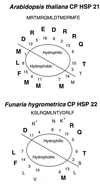Chloroplast small heat shock proteins: evidence for atypical evolution of an organelle-localized protein
- PMID: 10588716
- PMCID: PMC24447
- DOI: 10.1073/pnas.96.25.14394
Chloroplast small heat shock proteins: evidence for atypical evolution of an organelle-localized protein
Abstract
Knowledge of the origin and evolution of gene families is critical to our understanding of the evolution of protein function. To gain a detailed understanding of the evolution of the small heat shock proteins (sHSPs) in plants, we have examined the evolutionary history of the chloroplast (CP)-localized sHSPs. Previously, these nuclear-encoded CP proteins had been identified only from angiosperms. This study reveals the presence of the CP sHSPs in a moss, Funaria hygrometrica. Two clones for CP sHSPs were isolated from a F. hygrometrica heat shock cDNA library that represent two distinct CP sHSP genes. Our analysis of the CP sHSPs reveals unexpected evolutionary relationships and patterns of sequence conservation. Phylogenetic analysis of the CP sHSPs with other plant CP sHSPs and eukaryotic, archaeal, and bacterial sHSPs shows that the CP sHSPs are not closely related to the cyanobacterial sHSPs. Thus, they most likely evolved via gene duplication from a nuclear-encoded cytosolic sHSP and not via gene transfer from the CP endosymbiont. Previous sequence analysis had shown that all angiosperm CP sHSPs possess a methionine-rich region in the N-terminal domain. The primary sequence of this region is not highly conserved in the F. hygrometrica CP sHSPs. This lack of sequence conservation indicates that sometime in land plant evolution, after the divergence of mosses from the common ancestor of angiosperms but before the monocot-dicot divergence, there was a change in the selective constraints acting on the CP sHSPs.
Figures



Similar articles
-
Analysis of gene sequences indicates that quantity not quality of chloroplast small HSPs improves thermotolerance in C4 and CAM plants.Plant Cell Rep. 2012 Oct;31(10):1943-57. doi: 10.1007/s00299-012-1307-z. Epub 2012 Jul 14. Plant Cell Rep. 2012. PMID: 22797908
-
The diversification of plant cytosolic small heat shock proteins preceded the divergence of mosses.Mol Biol Evol. 1999 Jan;16(1):127-39. doi: 10.1093/oxfordjournals.molbev.a026033. Mol Biol Evol. 1999. PMID: 10331257
-
Comparative analysis of the small heat shock proteins in three angiosperm genomes identifies new subfamilies and reveals diverse evolutionary patterns.Cell Stress Chaperones. 2008 Summer;13(2):127-42. doi: 10.1007/s12192-008-0023-7. Epub 2008 Feb 26. Cell Stress Chaperones. 2008. PMID: 18759000 Free PMC article.
-
Plant small heat shock proteins - evolutionary and functional diversity.New Phytol. 2020 Jul;227(1):24-37. doi: 10.1111/nph.16536. Epub 2020 Apr 16. New Phytol. 2020. PMID: 32297991 Review.
-
The evolution, function, structure, and expression of the plant sHSPs.J Exp Bot. 2013 Jan;64(2):391-403. doi: 10.1093/jxb/ers355. Epub 2012 Dec 18. J Exp Bot. 2013. PMID: 23255280 Review.
Cited by
-
Substitution of conserved methionines by leucines in chloroplast small heat shock protein results in loss of redox-response but retained chaperone-like activity.Protein Sci. 2001 Sep;10(9):1785-93. doi: 10.1110/ps.11301. Protein Sci. 2001. PMID: 11514669 Free PMC article.
-
Evolutionary diversity of vertebrate small heat shock proteins.J Mol Evol. 2004 Dec;59(6):792-805. doi: 10.1007/s00239-004-0013-z. J Mol Evol. 2004. PMID: 15599511
-
Alpha-crystallin-type heat shock proteins: socializing minichaperones in the context of a multichaperone network.Microbiol Mol Biol Rev. 2002 Mar;66(1):64-93; table of contents. doi: 10.1128/MMBR.66.1.64-93.2002. Microbiol Mol Biol Rev. 2002. PMID: 11875128 Free PMC article. Review.
-
Structural model of dodecameric heat-shock protein Hsp21: Flexible N-terminal arms interact with client proteins while C-terminal tails maintain the dodecamer and chaperone activity.J Biol Chem. 2017 May 12;292(19):8103-8121. doi: 10.1074/jbc.M116.766816. Epub 2017 Mar 21. J Biol Chem. 2017. PMID: 28325834 Free PMC article.
-
Analysis of gene sequences indicates that quantity not quality of chloroplast small HSPs improves thermotolerance in C4 and CAM plants.Plant Cell Rep. 2012 Oct;31(10):1943-57. doi: 10.1007/s00299-012-1307-z. Epub 2012 Jul 14. Plant Cell Rep. 2012. PMID: 22797908
References
Publication types
MeSH terms
Substances
Associated data
- Actions
- Actions
Grants and funding
LinkOut - more resources
Full Text Sources
Miscellaneous

